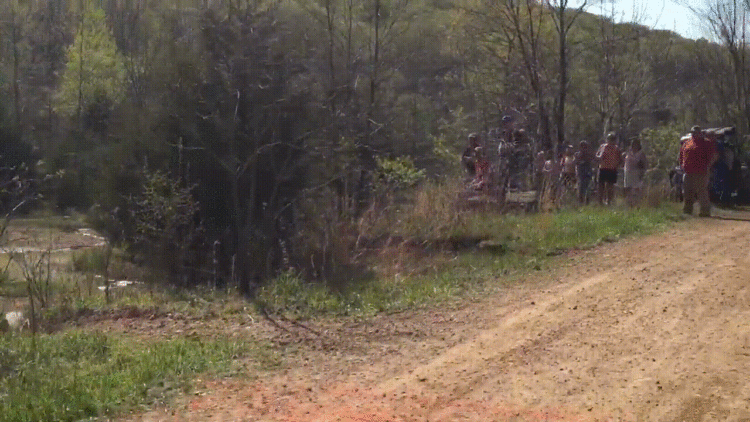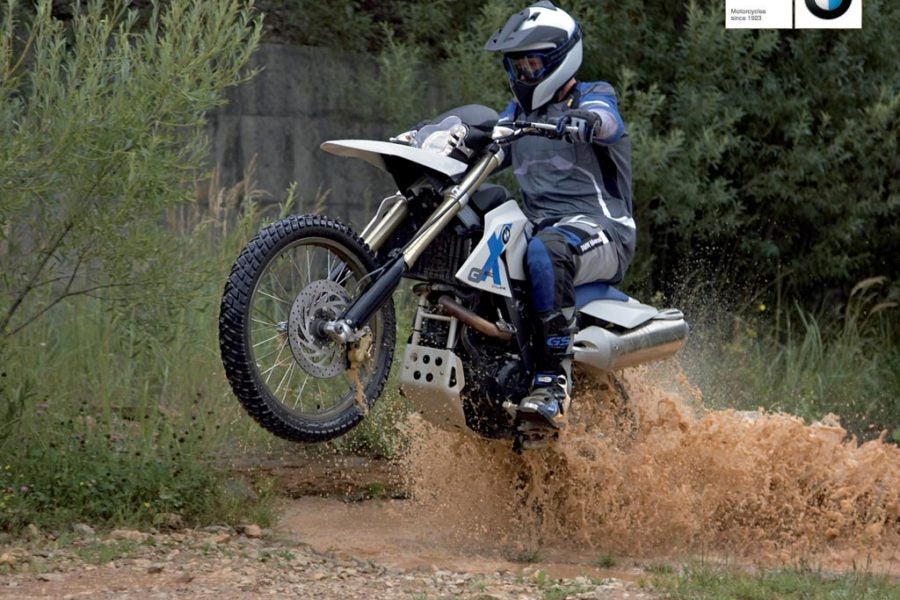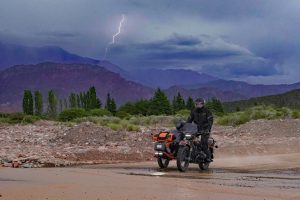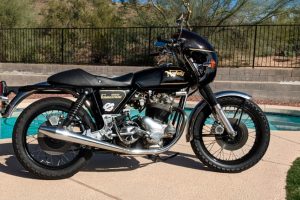This guest post was kindly contributed by Colin Fogarty.
From time to time, BMW Motorrad is bold and creative. There is no shortage of examples of BMW developing a new bike or adding life-changing technology to existing platforms. Oftentimes, it achieves great success (read that with Borat’s voice) as is seen with their first G/S back in 1980, arguably the first big-bore adventure bike, or the addition of ABS in 1988. Other times, the company’s “creativity” doesn’t work out as hoped—for example, the servo-powered brakes found on the R1150 oilheads.
One of those projects that received skepticism initially, but deserves revisiting, is the BMW X-series line up, built from the late 2000s through the early 2010s: G450X, G650X, and HP2.

In 2007, BMW was all in for the new X-line, including launching a marketing campaign entailing rally events featuring the likes of Jimmy Lewis. It even hosted a forum, similar to ADVrider. It was shuttered when BMW stopped making the lineup in 2010.
The X series was BMW’s attempt to create dirt-oriented enduros like KTM’s machines, to attract a new set of younger, more adventurous riders. The worm on the hook was this: BMW would bring its reputation for reliable, less maintenance-intensive platforms and meet the same performance level as their Austrian counterparts.
Now, a decade after production ended, those whoownedX-series machineslove(d)them and wish BMW would have stuck with the line and continued to refine the platform. Non-owners know mostly of their shortcomings and short-lived production. This elegy seeks to admit the problems, but also provide some missing praise for these still-capable platforms.

Photo: BMW
G650X
Addressing the bikes out of order in terms of size and release date, I’ll first speak to the G650X.
The G650X was a collection of three bikes that were based on BMW’s 652 cc platform. The engine, originally developed in 1992 (released in ’93), represented the first Bavarian foray in the single cylinder game since 1966 (that thumper,the R27, was only a 250 cc).
The 650 engine was well-received and routinely revised over time; 2007 represented the last changes in the platform when BMW dropped a gear and a high-power charging system for less weight and more power.
The Xchallenge was the flagship for this series. Billed as a“hard enduro”这不是开创性,但令人印象深刻15-year-old platform: 52 horsepower, 44 pound-feet of torque, 270 millimeters of front fork travel, and 344 pounds wet weight. The engine was predictable, smooth, and torquey, easily pulling a wheelie using the throttle alone. When it was released, it was praised in the press. The machines required limited maintenance and they were easy for a shade-tree mechanic to wrench on. On paper, a worthy adversary for the KTM 640 and KTM 690. In practice, an undisputed runner-up.

Photo: BMW
What limited the 650X platform wasn’t the engine, but short-sighted engineering on critical components.
The biggest problem was the suspension addressed in two parts: The front forks and rear shock.

These forks were used on the 650X and the HP2. It utilized one leg for compression and the other for rebound. While commonplace today, this was novel back in the early 2000s. Photo:hscarborough.
The front: BMW contracted with Marzocchi to build USD forks. These forks were adjustable (suspension and compression, not preload) a BMW first. But, they were soft, made for the mythical 160-pound rider. Worse, they were poorly valved and utilized crimped construction (preventing valve adjustment). If imitation is the finest form of flattery, KTM shouldn’t be flattered. The forks didn’t compare to the WP standard on KTM enduros. That evaluation notwithstanding, they were better than what you would find on a KLR, DRZ, or similar mid-level dual sport bike. Had the bike been made post 2013, cartridge drop-ins from the likes of Touratech, Ohlins, or Andreani could have saved the front end suspension.

Photo: Continental
The rear end was supported by a lightweight air system made by Continental (known for reliable tires, not for motorcycle suspension). Cool idea, but poorly executed. The air suspension offered two settings, “hard,” and “soft,” controlled by a flathead screw. The preload was set by hand pump with a bubble balance up front to help determine sag (again, cool idea). But the “air-bag” was more of a cannon. When the bike would go through a large compression the ensuing rebound made amateur physicists scratch their head as the kinetic energy was seemingly greater than the potential. Most serious riders swapped up to Öhlins. The G650 Xmoto and G650 Xcountry relied on a traditional rear shock, but it was undersprung and didn’t offer any real form of compression/rebound adjustment. In all, the suspension was adequate but not what BMW should have done.

The legendary X-Tank. It not only provided extra fuel, but it increased the rigidity of the subframe, solving two of the G650x’s problems. Photo: HotRodWelding
另一个问题是油箱;宝马把一个小2.3-gallon tank on the bike to reduce weight. That was enough to get you from stop to stop on most BDRs . . . but not a mile more. If you wanted to tackle the Trans American Trail (TAT) you needed an additional fuel cell. There weresolutionsto this, (particularly thex) * tank). But, given BMW’s reputation for building long-distance bikes, the designers should have anticipated that the majority of riders would need (or at least want) more fuel capacity.
The last problem, for production year 2007, was the aluminum subframe. When fat riders (like me) or ADVers loaded up on gear put the bike through its paces, that frame would snap; because of this, there was a new steel sub-frame in 2008 and 2009. The aftermarket also came into play here, offering its own replacements.

Picture of yours truly (@CGGUY09) finishing the GS Challenge in 2016.
Now, that may sound like a long list of complaints, but most could live with problems; those that couldn’t were able to easily ameliorate them through aftermarket or post-2007 parts. You could install heavier springs, swap in a new shock, and so on.
If you did that, the bikes were true dirt contenders. Perhaps not a KTM-killer, but a capable bike that could do any BDR and TAT with ease. The G650 X earned a reputation as a rugged and reliable machine with an outstanding powerband. Further, it delivered on the minimum maintenance periods, with many riders willingly changing their oil and consumables past BMW’s recommendations. As proof of the engines’ longevity, there are no shortage of 650 Xs running around with 70k+ mile engines with routine valve adjustment the only major maintenance item.

Photo: @FreeTheBeast
G450 X
Unlike the G650 X, which was based on a 15-year-old platform, the G450 X was fresh and novel, with all-new engine and chassis. The engine rotated backwards, the clutch was on the crank, and the swing arm and counter sprocket shared the same pivot point. It boasted 51 horsepower in High Power Mode (41 horsepower in Low Power mode) Akropovic exhaust, 300 millimeters of fork travel, and 320 millimeters of rear travel on an Öhlins shock. Much like its big brother, on paper the G450 X was great. In practice, it needed more time to develop to overcome initial growing pains.

Mr. Knight poses with his factory custom 2009 G450x. Knight is a legendary rider who repeatedly placed first in the World Enduro Championships but would leave mid-season while racing with BMW in 2009.
When the bike was released, BMW hired ace rider David Knight to race the bike. From the start, there was friction between Knight and BMW. He started by asking the team to swap WP forks for the Marzocchi stockers. That’s not outlandish, as most production bikes aren’t exactly the same as racing setups (I’d want the same thing).
But, when Knight began losing, he blamed the bike specifically, citing the clutch and complaining of the ergonomics. While the ergos needed addressing, it didn’t seem to slow down Knight, but the clutch sure did! Knight would be winning a race and on the final lap(s) the clutch would overheat and lose all friction. This happened three times, costing the racer the checkered flag each time. Before BMW could fix the problem, the motor company and theracer parted ways. Not a good way to introduce a brand new platform. Although, it should be noted that BMW did experience racing success with this bike: the company won the2009 Red Bull Romaniacsand placed second in the world enduro championship withJuha Salminen. As for Knight’s performance, he had a respectable three sixth-place finishes before he threw in the towel (this with a fried clutch!).
A few words on that clutch problem: Most riders are not slipping the clutch at 8000 rpm for 80 minutes straight like Mr. Knight. Heck, most legit trials guys aren’t either. For those that are familiar with the bike, the clutch is considered bulletproof—a strong point in the engine. This topic was candidly discussed ona recent Adventure Rider Radio episodewhen Clint Smout ofSMART Adventures(who modestly called himself “not a good enough rider”) noted that he never had an issue with the G450 X clutch. The G450 X conversation starts at 48:12, but the whole episode is certainly worth a listen!

The 2010 BMW’s tell-tale is the gold forks. The 2009 had black forks as well as more understated plastics. The fork rake and fork internals were the two largest changes for 2010. Photo: BMW
BMW made主要refinements第二年。2010年G450 X贝蒂r ergonomics, better fueling, better forks, better shock, better gearing, better seat, better exhaust, and other minor improvements (better, better, better!). The improved ergos made steering more predictable and improved rear wheel traction. Most people who have ridden the2009and 2010, consider them two different bikes. In general, the 2010 is viewed as a worthy platform for single track and technical riding. The 2009 is viewed much less favorably.

A rear Safari Tank, doubling the petrol capacity for the G450 X. Photo: @JackSplash
Despite improvements, silly problems remained: the small gas tank proved to be hereditary—the 8-liter G450 X tank could get you about 100 miles (maybe) and not more. The crankcase vent ran through the torque limiter, causing the part to prematurely fail. Nothing some well-designedinexpensive partscouldn’t fix, but still unnecessary, self-inflicted design wounds.
Ultimately, BMW cut its losses after 2010 and gave the platform to Husqvarna (then owned by BMW). Husky continued production in the form of theTE449and TE511. Those lines were produced until BMW sold Husky to KTM. The engine lived on in detuned form (low power mode) in theCCM GP450until 2017, when emissions regulations forced an end to production. Notably, the Husky and CCM models corrected all problems with the exception of the crankcase vent.

Another fine picture from @JackSplash demonstrating how to get extra miles out of the bike!
One item of debate among owners is the maintenance schedule. BMW provided a crazy maintenance schedule, when the bike was released. But, it also offered an unlimited-hours, 36,000-mile, three-year warranty. Most owners believe BMW was trying to hedge its bets against riders who would race the bike outright and demand a new engine every 100 hours under the warranty. In practice, most people treat this bike like any other BM—changing oil every 3k–5k miles as provided for by Husky’s TE-449/511 & CCM’s GP450 maintenance guidelines.

2010 G450 X cutting it up in Oregon
For all its idiosyncrasy, the 2010 G450 X is a great platform capable of serious riding. It is light, narrow, powerful, and street-legal. If the rider had access to gas or an auxiliary tank, it is a near unstoppable machine. Concerning maintenance and reliability, 2009 had a number of problems that were largely solved in 2010. There are a number of high-hour/high-mileage G450 Xs that haven’t had a rebuild. Maintenance items were all doable, but given the engine’s location in the trellis frame and the co-location of the counter-sprocket with the swing arm, the weekend-mechanic had to do a little more thinking than might have been needed with a KLR if the maintenance was more than an oil or coolant change. Had BMW continued to develop the platform, I suspect riders (even Mr. Knight) would have come to appreciate the oddities and come around to the bike.

Photo: BMW
HP2
While not bearing the “X” moniker, the HP2 is undoubtedly part of the X family. Its air-shock and forks are shared by the X-Challenge, its headlight with the X-Country, the trellis tube frame with the G450 X, and it carries the same anemic gas tank as every other X-series bike. Most importantly, it shares the same spirit of a lighter, more powerful BMW off-road platform.

An example of the “complimentary” set of street rims that came with your $20,000 dirt bike. Photo: BMW
Relying on BMW’s tried and true oilhead platform, the HP2 shed weight and comfort in the name of power. At 387 pounds wet with 105 horsepower, this bike is an offroad monster and has developed a notable cult following. As demonstrated by the bike’s retaininghigh-resale valuedespite being 15+ years old. It initially sold at $20k from 2005 to 2008, but BMW scrapped the bike a year before switching to the camhead line. BMW didn’t anticipate these bikes to sell given the high price tag and the niche market. And they weren’t wrong; eventually, BMW had to include an additionalwheel set帮助潜在买家在面团叉。

(Credit @JackSplash)
The complaints about the bike surrounded the suspension and the gas tank (sound familiar?). The HP2 relied on the exact same air-shock and Marzocchi forks as the X-Challenge (if you don’t believe me, stroll over to Max BMW and check out the part fiche). The suspension should have been better and would have been improvable had drop-in cartridges been available in 2008. Also, the HP2 suffered from a fairly soft front brake.

ATGATT be damned! An HP2 doing a sweet jump at the 2008 BMW XPLOR event. Photo: @JackSplash
Unlike her little siblings, the HP2 was well-received by those who could afford it (and journos, who got to ride it for free). Despite having the same shortcomings as the G450 X and G650 X, people loved this undersprung, overpowered, dry-clutched machine. As evidence, companiesstillmake and adapt aftermarket parts to fit the bike despite being out of production for more than 13 years. Remember when I just lamented about cartridges? Guess what, there are multiplecompaniesthat makedrop-insnow. (X-Challenge riders, take note, those will fit in your forks!)

A 2007 XPLOR event. On hand, a number of X-Challenges and an HP2. Photo: @JackSplash
Summary
The X-series bikes had drawbacks, all of which were self-inflicted wounds by our beloved Bayerische Motoren Werke. Had BMW invested in better suspension and a bigger gas tank, I suspect we’d be reading Bill Roberson’s article on the 2022 G450 X EICMA release. Despite the untimely death, all these bikes have proven to be reliable and capable bikes. With ADVrider ingenuity, the shortcomings are easily overcome and these bikes have accomplished the same trails and RTW rides as any of their counterparts. If you’re in the market for a bike and see one of these torque monsters for sale, don’t pass it by without a second look.







